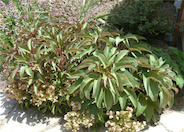
Common name:Japanese Maple
Botanical name:Acer palmatum
This magnificient plant can used as a small tree or shrub. It is deciduous with graceful leaves which have a scarlet color in spring as it leafs out. Leaves later turn orange or yellow in fall. It is slow growing to 20', and requires shelter from the hot sun. The leaves of this tree are small, light green in color, and deeply lobed. It should also be noted that this tree remains spectacular throughout all seasons. (2nd photo courtesy of Steve Mullany)

Common name:Hybrid Helleborus or Hellebore
Botanical name:Helleborus hybrids
The Helleborus hybrids are evergreen plants that are a favorite for many gardeners due to the variety of flower colors and ease of growth. They maintain their dark green, glossy foliage through winter. By late winter, cut back the old foliage to view the emerging flower stalks. It prefers rich, well-drained soil and light to dark shade. It looks great in mass plantings under trees or large shrubs for a woodland effect. Leaves, stems and roots are poisonous

Common name:Western Azalea
Botanical name:Rhododendron occidentale
The Western Azalea is a deciduous shrub that grows 6'-10' tall. It produces fragrant, showy, white to pink flower clusters in spring. This shrub prefers shade and is hardy to -5 degrees F. Western Azalea is native to CA, prefers well draining, moist soil. Bees and butterflies love Western Azalea.

Common name:Star Jasmine
Botanical name:Trachelospermum jasminoides
The star jasmine is an evergreen vine that grows 20 ft. tall or a ground cover that reaches 1-2 ft. tall and 4-5 ft. wide. It has white fragrant flowers in the summer and can tolerate sun or partial shade. The star jasmine is also drought tolerant. -Cornflower Farms
Designer: Linda Engstrom
Photographer: Linda Engstrom
Physical weed control, including mulching, or hand removal protects the watershed from harmful chemicals.
Adjust sprinklers to avoid watering sidewalks and driveways.
Remove irrigation water and fertilizer from areas where you don't want weeds to grow.